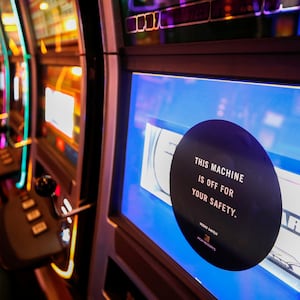At one hospital in North Dakota, nurses are being forced to test patients for the deadly coronavirus with only a surgical mask. And across the state, scores of nurses are working several overnight shifts in a row, scared to speak up as North Dakota grapples with a rapid coronavirus spike that’s left hospitals facing a dangerous shortage of beds.
On Monday, state officials announced a seemingly counterproductive band-aid to combat the tidal wave of cases that have overwhelmed the mostly rural hospital system: COVID-19 positive nurses and other health-care workers can come to work.
Now nurses are mad as hell.
“Nurses are very highly trusted in our community, and if we are saying we can go back to work after testing positive, how do we expect the public to take this pandemic seriously?” Tessa Johnson, president of the North Dakota Nurses Association, told The Daily Beast.
“I have heard that from a lot of people that they are at their breaking point. I think we are going to lose nurses from this. It has affected everyone in a different way,” she added.
But while several North Dakota nurses told The Daily Beast they are “terrified” of the virus, they insist they’ll still show up for their increasingly dangerous jobs because “that’s what nurses do.”
“Nurses don’t feel safe. They don’t feel like they have adequate PPE and everyone is concerned about short staffing and they don’t feel supported by state leadership,” Johnson, who is also the executive director at a senior long-term care facility, said. “But they are going to continue to go to work and put themselves at risk because that’s just what nurses do—even if they are hanging by a thread.”
As of Monday, North Dakota medical professionals with asymptomatic COVID-19 cases can continue to work in COVID-19 units at hospitals and nursing homes. It’s one of several steps taken by hospitals and officials as part of their “surge plans” to curtail the virus that has moved the entire state into the “high-risk” category.
“This applies only to COVID-positive health-care workers who do not have symptoms, and they are allowed only to work COVID units around patients who already have the virus,” North Dakota Gov. Doug Burgum said Monday.
The move, Burgum insisted, aligns with CDC guidelines that allow asymptomatic medical personnel to work during severe staff shortages.
These changes come even as elected leaders in North Dakota—which, according to one survey, has the lowest rate of residents using face coverings in the country—repeatedly refuse to institute a mask mandate or any other forceful COVID-19 mitigation plan.
One North Dakota nurse, who wished to remain anonymous for fear of professional retribution, said the state’s unprecedented step to allow those with the virus to treat patients “is short-sighted at best—and completely detrimental at worst.”
“We need state officials to take decisive, hard-line decisions to combat this virus or else our hospital system is completely going to collapse,” the nurse said, adding that she has several colleagues and friends who have had the virus. “Allowing health care workers with the disease to treat patients with the same disease is not going to help anything. It only makes the problem worse.”
Another nurse, who works in Bismarck, told The Daily Beast that she doesn’t know how much longer she is willing to put herself and her family in danger for a state that doesn’t seem to “have her back anymore.”
Johnson pointed out that COVID-positive nurses won’t be isolated with virus patients and could spread the deadly virus to their colleagues in “bathrooms and dining rooms and break rooms and elevators.”
Not only is it “unrealistic” to contain a “highly contagious” virus to specific hospital wings, she said, but the new measure “is only going to make things worse” because it will add to nurses’ stress and prevent them from getting rest in areas of the hospital “where they should feel safe.”
As the epicenter of the coronavirus outbreak in the Midwest, North and South Dakota currently have the nation’s worst rate of deaths per capita. And while the coronavirus is spiking at an uncontrolled rate in dozens of states across the country, North Dakota’s daily average for new cases, hospitalizations, and deaths put the state at the top, according to ProPublica.
The North Dakota Department of Health on Thursday reported 1,801 new cases in the state, bringing the total to 59,173, with a positivity rate of about 18.7 percent. Last week, the state had 171 coronavirus cases per 100,000 people, the highest per capita rate in the country, according to the CDC.
Officials also revealed 11 people died from the virus on Thursday, bringing the state’s death toll to 697. The dead include David Andahl, a North Dakota Republican state legislative candidate who passed away in October—but still ended up winning his seat.
Health experts are concerned about the trajectory of the state of 762,062 Americans, especially as neighboring states experience similar surges.
Dr. Amesh Adalja, a senior scholar at the Johns Hopkins Center for Health Security who specializes in infectious diseases, believes North Dakota’s virus trajectory officially puts it in “crisis.”
“This state does not have a lot of medical resources, meaning it has a low threshold to be overwhelmed if something goes awry,” Adalja told The Daily Beast, adding that the state’s surge “is a lesson for what happens for when you don’t plan for cases.”
On Wednesday, the health department revealed that some residents have tested positive for COVID-19 multiple times, and officials said they’ve launched an investigation to determine whether those cases are, in fact, reinfections.
“Our cases are people who have tested positive twice, developed symptoms a second time, most with more than 90 days in between positive results,” a health department spokesperson told The Forum.
Adalja, however, insists North Dakota’s decision to allow health-care staff to continue to work with “acute infections” is more “a sign of the times” than a dangerous decision that could lead to re-infections.
“Re-infection is something that is very rare. These medical personnel are acute cases working with patients that are already infected,” Adalja said. “That being said, it will get worse in North Dakota before it gets better.”
Gov. Burgum has moved every county in the state to a “high-risk” level, signified by the color orange. The level, one step below shutdown measures never used in the state, limits all bars and event venues to 25 percent capacity. On Monday, Burgum outlined several other initiatives to stem the crisis, including hiring EMTs and paramedics to run testing sites.
“Our hospitals are under enormous pressure now,” Burgum added. “We can see the future two, three weeks out, and we know that we have severe constraints.”
Sanford Health, one of the state’s largest health-care systems, also announced Thursday it will be sending hospital patients to a nearby nursing home in Fargo to recover in an attempt to free up hospital space. According to The Forum, the nursing home is opening a wing that will provide 24 additional beds for a hospital system that is already at “very high capacity.”
The North Dakota Nurses Association has blasted state leadership for allowing COVID-positive medical workers to keep working. In a Wednesday night statement, they said that it should be a health-care workers’ choice to stay on the job while COVID-positive—rather than their employers.
“If a nurse believes they are not well enough to provide safe patient care and chooses not to work under these circumstances, employers should not retaliate against the nurse for making this decision,” the statement read, adding that the state should be pressing COVID-19 mitigation guidelines, like mandating mask-wearing and social distance.
The North Dakota Emergency Nurses Association on Wednesday night also released a statement against the new policy, urging lawmakers to institute a statewide mask mandate and other CDC mitigation guidelines before resorting to a “crisis strategy.”
Johnson said nurses are already putting themselves on the line for their patients daily.
“They are probably positive health-care workers who haven’t been tested,” Johnson said. “Everyone is already putting themselves at risk for this virus. We’re preparing for a very, very dark week to eight weeks unless a drastic change happens.”










